Assassin Nation Week: Kyle Starks on the Art of Joke Writing, Action Sequences, Scripting and more
This week’s Assassin Nation here at SKTCHD, and we’re starting things off with a chat with series writer Kyle Starks. I’m a big fan of Starks’ work on titles like Sexcastle and Kill Them All, but as much as I enjoy those action comedies, Assassin Nation – his Skybound/Image series with artist Erica Henderson and letterer Deron Bennett – is probably my favorite thing he’s written yet.
And today, I’ll be chatting with Starks all about that series, its development, what his writing process is, joke writing, working with an artist on a book, and a whole lot more as we zero in on issue #3, all the while providing looks at how his scripts compare to the finished product. Give it a read below, and come back tomorrow as we chat with artist Erica Henderson on day two of Assassin Nation Week.
Before we get into the specifics of bringing an issue of Assassin Nation to life, I wanted to start with the work that goes into it beforehand. I know you and Erica are buds. You wanted to work together already, and you pitched her on this. For you, what was the origin of the idea for Assassin Nation, and how did it evolve once you knew you were working with Erica on it?
KS: Erica and I had sort of tossed a couple ideas around in the past just like potential ideas one almost worked out and the other was a non-starter but with her being on Unbeatable Squirrel Girl and then Unbeatable Squirrel Girl and Jughead at the same time and then USG and the USG OGN I mean, it didn’t ever really feel like it would ever happen. I met Erica at the first major show I ever tabled at and we became good friends nearly right away.
Back then we had nothing and were nobodies but within a year or two she had USG and I had Sexcastle at Image – our careers sort of started at the same time and it’s good to have someone who’s having similar experiences. (albeit one wildly more successful, obviously). Anyway, my point was that these ideas were pretty hypothetical anyway because as far as I was concerned Erica was going to be working on Major Projects from here on out and wouldn’t have time to work with, friend or not, a relatively small name creator.
But we had talked about it.
I had came up with Assassin Nation about a month before NYCC and, I believe, after hearing Skybound was potentially interested in working with the two of us I pitched it to her and she said yes. Now, if Erica wouldn’t have drawn it, I would have. It’s an idea I was pretty excited about and right up my alley: hitmen, big action, fun characters.
At the time I had only very general ideas of what it would be – the name, the basic plot, the story beats, etc. How things changed with Erica is that it was going to be drawn much better than if I did. I didn’t have to change anything knowing Erica would be doing the art because Erica knows how to draw all the things I draw in my books, and like in my stories. She does stellar comedy work – which is very hard and rarer than you’d think – and action and, you know, everything else. But I knew this was something Erica would kill because we have such similar tastes and likes and she’s proven it something she’s super capable of. I mean, the best part, probably was me throwing a bunch of idiotic names at her and seeing what she came up with. Her character design is so incredible.

Script for Assassin Nation #3, Page 1 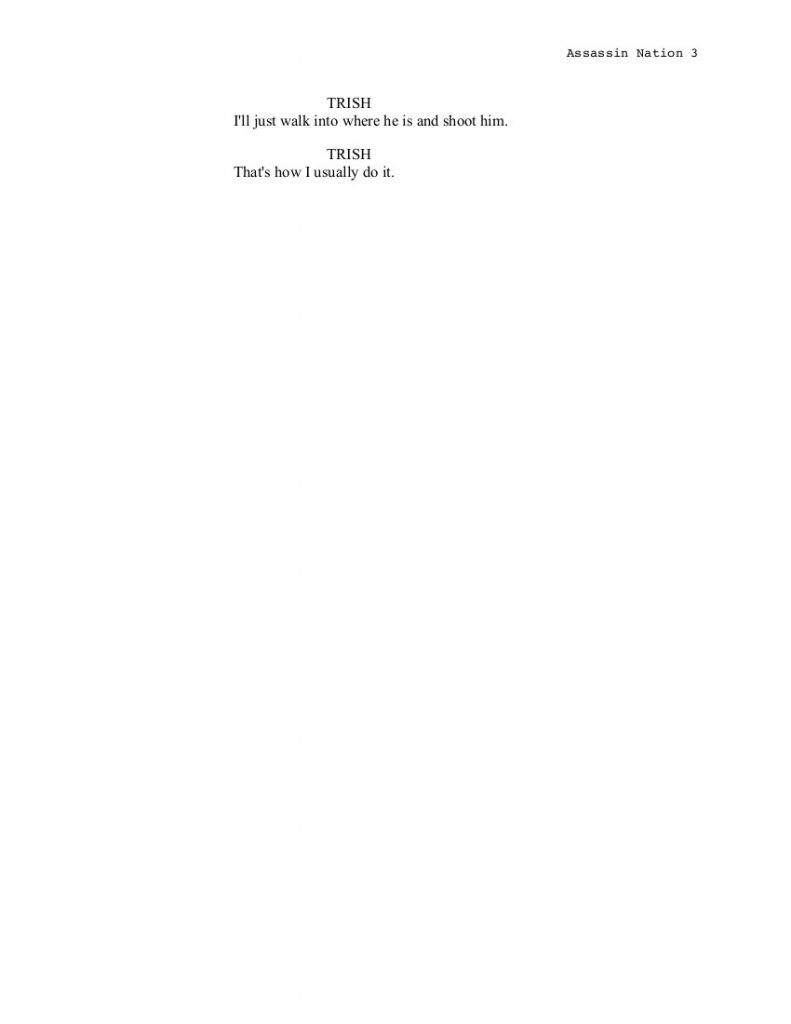
Script for Assassin Nation #3, Page 2 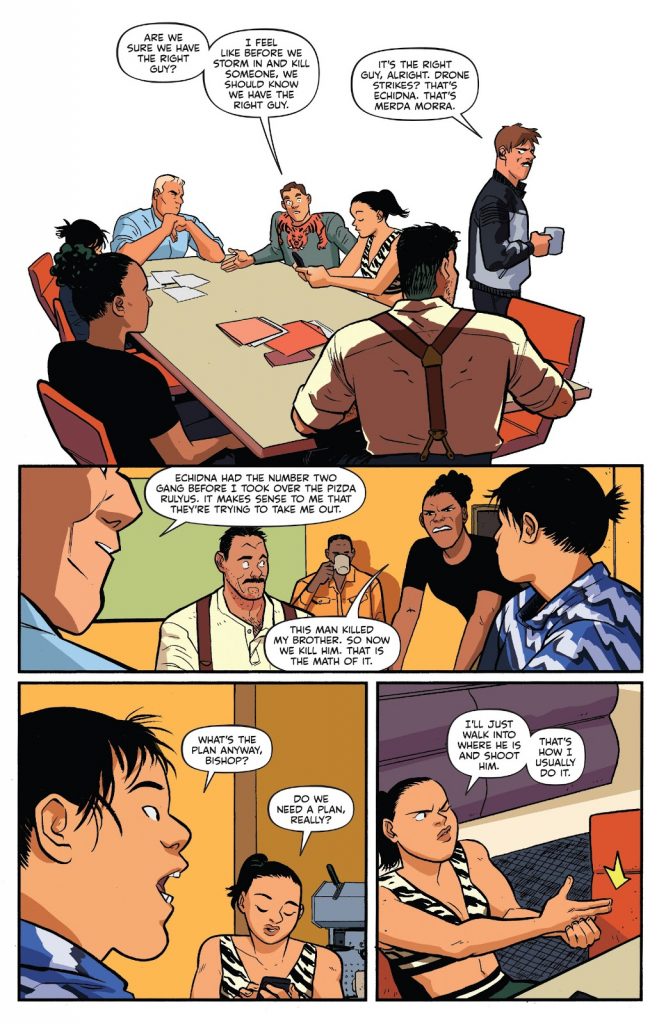
Page 1 of Assassin Nation #3
In an interview with The Beat, Erica specifically mentioned that your Assassin Nation editor Jon Moisan was there the weekend this really came together at New York Comic Con, and that he had said that he really wanted to work with you both. When it comes to the development side of things, how did working with Jon and Skybound impact your plans for this book? Or is your relationship more hands off as the series is first coming together?
KS: Erica and I had discussed a couple options other than Skybound but Skybound had the best package for her comfort and their sort of initial enthusiasm and interest I think was always in our minds. Erica and Jon were familiar with each other from the Squirrel Girl days and, while I don’t want to speak for Erica, I think that familiarity was super comforting and moving off a major project to something entirely different that type of thing is important. I’m not sure why I would be hands off for a series coming together – I think this book wouldn’t have come together without me suggesting it to both Jon and Erica and then shepherding it through the pitch process, but Erica was 100% my partner and equal all the way through and I didn’t do anything without her approval
When you’re putting a series like this together, do you have a framework for how plotting will break down on an issue by issue basis before you get started writing the issues themselves, or do you just have a broader idea for the series and then you see how everything fits in as you go along?
KS: We knew it was going to be 5 issues coming in, and knowing the story I wanted to tell – which had a beginning, middle and end – then it’s a just a process of figuring out how to break that down into those 5 parts in the most interesting way. So I guess, the answer is, for me, I know the story – I know what it’s going to be in it’s entirety – and then I break it up. And sometimes breaking it up changes things but even when I’m working out that broader idea I’m thinking about how it will be told and read in chapters or issues or episodes.
When you’re focusing on a single issue, it sounds like you know the broad strokes of where it’s going, story wise. However, for something like issue #3, do you know other specifics, like the cutaway gag where a flashback underlines how right Smoke is about why an Asian woman in America could get away with crimes, ahead of time? Or are those beats mostly something that comes out in the nitty gritty of the writing process?
KS: So here’s how I do a book, basically, and when I say book, I guess I mean book in total.
I think about it for forever. Beginning, middle, end. I tell myself the stories over and over and until I really like them. And that’s everything – overall story, beats, dialogue, etc. And with this type of thing when I get a pretty general version of that I ran it by Erica to make sure I wasn’t crafting something she didn’t want a part of, but for the most part I tell myself a story. With a monthly book – with something episodic – figuring out where things start and end and how I break up the story is the second part. But when I’m doing all of this I’m thinking: these are things that happen here, these are the bits I want in it. So like the flashback was always here, Taipan wrecking everyone, the Cubs game bit, etc. Originally the Merda Merra gang had a couple of comedy characters that were sort of greek chorus for this issue that had to be cut for space, but it’s pretty much everything else I planned is all generally there.
Now, I then start writing dialogue. I don’t write panels, I don’t write descriptions, I just start writing what’s going to be said, the jokes, then I start breaking it up by page, what needs to happen on a page turn, etc. I write dialogue first then everything else second. But I write dialogue knowing what the scenes are going to be so, like, I know this scenes, then there’s this action scene, then this scene. So I’m writing to a scene, but also writing out the issue. Then I go back and break that up into panels and apply all the other stuff.
So sometimes some great stuff comes up at this dialogue stage but probably not something that requires a flashback for example, but I could point to a lot of things that I never planned that came up once I begin to actually start writing the book like the exchange between Dave and Fignerman before Taipan shows up or “sunburnt dicks” or “shooting a pimple” were spur of the moment. but I knew I was going to write “It takes two asses to spell assassin” from the jump. Because while I was thinking of the story I thought it was funny and it stuck for me retelling myself. So some bits are there from the start and some happen in the moment.
Fuck never having a weapon wasn’t really planned but when I was writing those scenes it was funnier to me that he didn’t and why he wouldn’t.
So while I come up with bits along the way, I also believe that good comedy needs to be written in the moment. Once I start writing this story, again, dialogue first, I’m trying very hard to make myself laugh. I didn’t plan the toilet bowl line in Rock Candy Mountain or the “You Brought a You To A Me Fight” in Sexcastle. That was just the space where I wanted to make me laugh and it did and my sincere hope is that if *I* think it’s funny then someone else will.
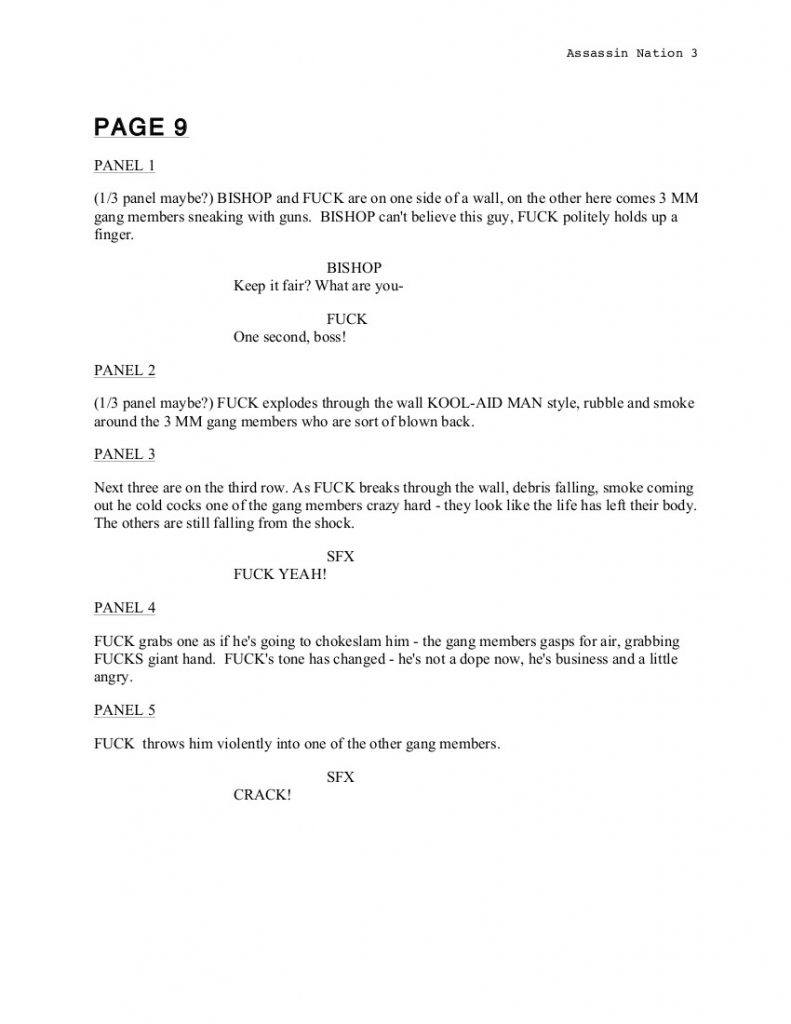
Script for Assassin Nation #3, Page 2 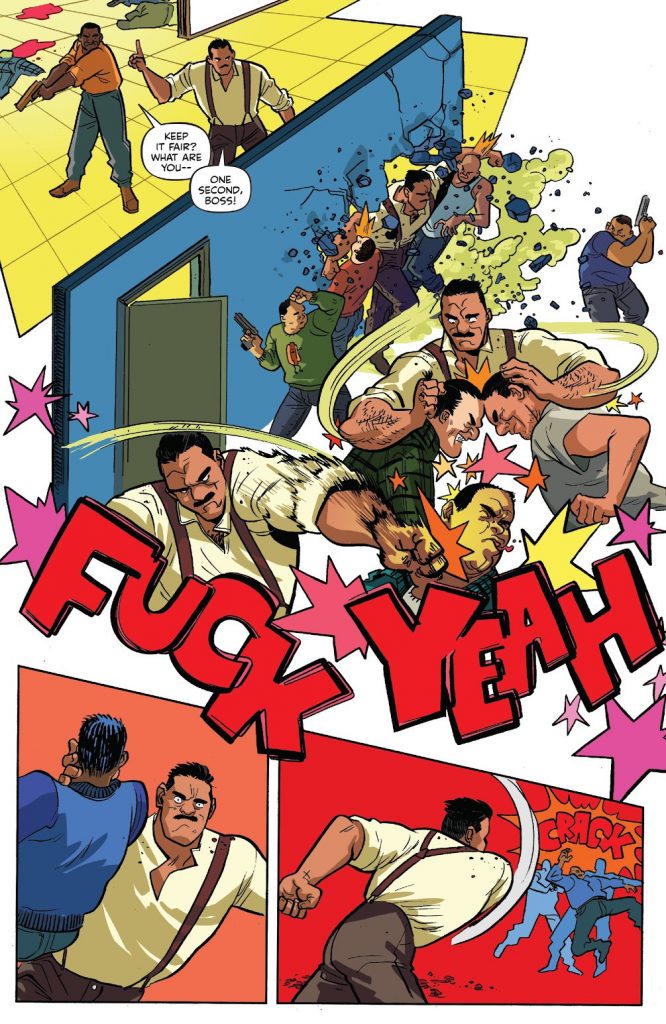
For such an influence driven book, do you ever have any mental guides or anything for yourself for specific sequences? The reason I ask is this issue’s whole action sequence – while different – reminds me a ton of the boat assault at the end of The Usual Suspects. Do you ever take inspiration from specific scenes, or is it more a feel thing you’re trying to achieve with your influences?
KS: You know it’s funny because reading this question I was sort of “Usual Suspects? Really?” And then immediately “Ohhhh yeah.” It definitely wasn’t an influence but I can see that. While I sometimes like to do a head nod towards certain action films that came before I try not to be derivative. I think it’s more the latter, years and years of influences that all sort of meld together at this point. But not always? But I never want to be derivative or copy. I probably watch any fight scene a little closer than your average person but I’ve also never ever taken a note. I probably should but I just really enjoy them? It’s more of I like what they did there, I like how it plays into the story, I like how cool it is, etc.
Obviously someone like Fuck Tarkington is someone who isn’t exactly deep. That said, each of these cast members offer something a little more than just a funny name, most of the time. You said it all started with their names, but when you’re working on something like this with a larger cast, do you have character breakdowns of what the cast is like to guide your writing of them? Or is it mostly feel based when you get into the book?
KS: I do not write out anything but I generally have things in mind for each character – either they’re based on someone – like Fuck most definitely is – or they’re formed around either a type of person, or an idea or a place someone mentally might be. There are a lot of characters in this book and very few are throwaway – a lot of the Merda Merra Gang obviously are faceless toughs, but even of the original Top Twenty only a couple I didn’t have an idea of who and what they are. But I don’t write anything down, I don’t have character sheets or whatever, I just spend a lot of time with these people before I ever go to page.
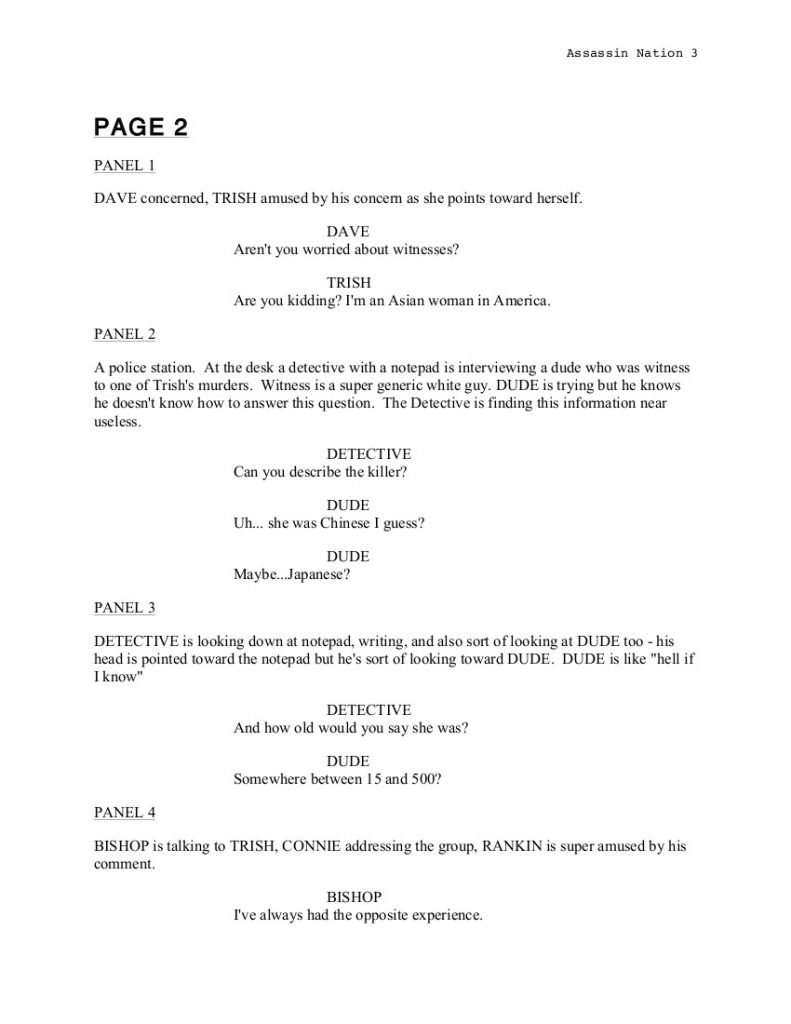
Script for Assassin Nation #3, Page 2 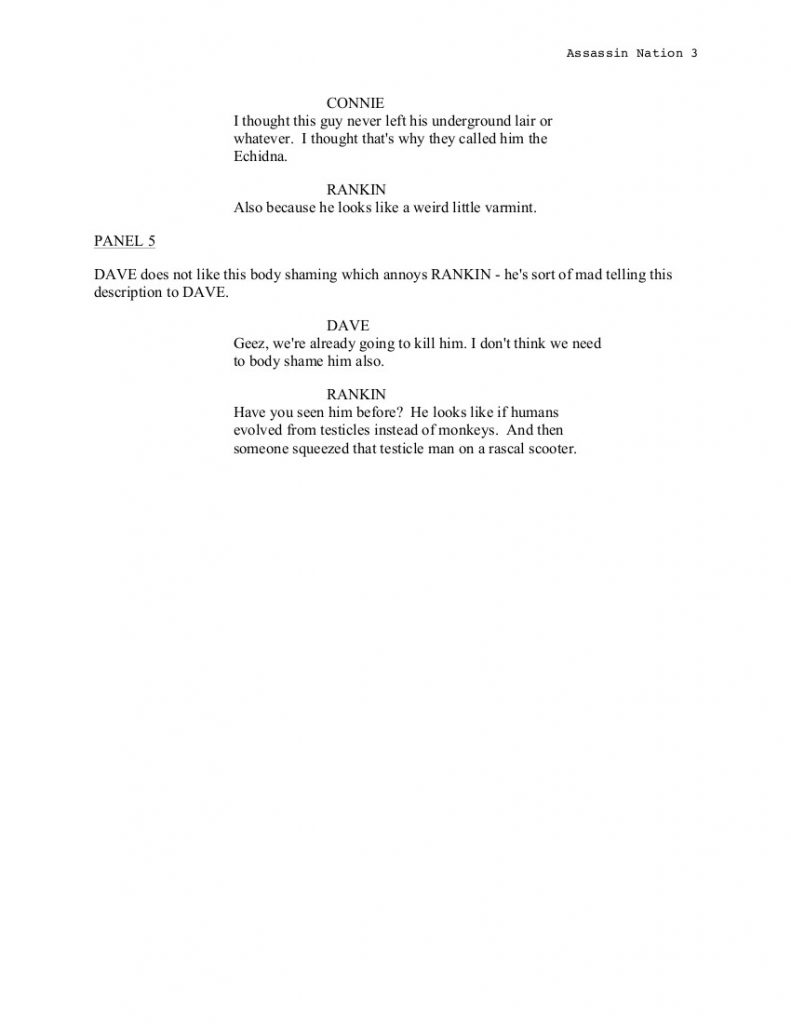
Script for Assassin Nation #3, Page 2 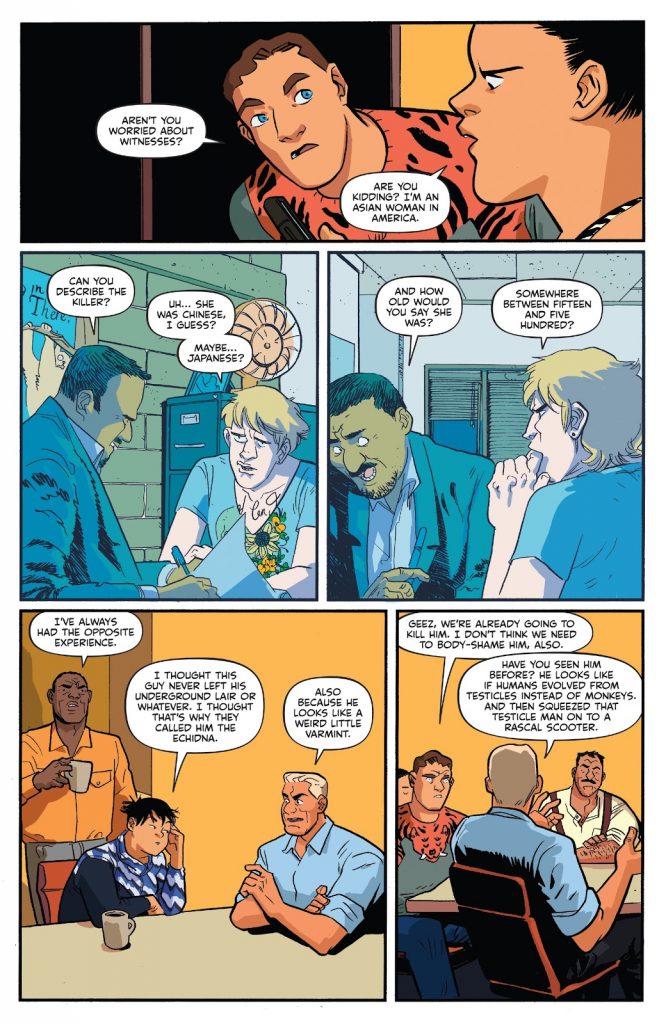
Page 2 of Assassin Nation #3
I wanted to ask about some specific beats in the issue, and I wanted to start with that cutaway gag I mentioned before in which we see a man reporting an Asian woman to the police but can’t get anything about her correct. While flashbacks are definitely a thing in comics, cutaway gags like that – which we mostly see in TV comedies like Arrested Development, Parks and Recreation or Family Guy – are pretty rare in comics. Little bits that underline a joke with an otherwise unrelated scene. What made a beat like that something you wanted to include in the book?
KS: I love flashbacks. I think I have flashbacks in nearly everything I’ve done? I think showing these characters before the current moments we’re living with them give them so much more depth – and not just characters in that regard, but the story itself too. That particular bit was something I had thought up pretty early that I really wanted in the book. I think Bishop’s reaction to that flashback also is very important, very good.
The action sequence that plays out in this issue uses the environment in very specific ways, especially when Chad Fingerman makes a rather bold move out a window with a sniper rifle. So the setting is important here. Are the specifics of what this area needs to be something you notate in the script, or do you just lay out the idea and Erica figures it out on the page?
KS: This calls back to an earlier question, I suppose. This was a set piece I had in mind as part of my general plan for the series so I wrote it out pretty directly. It may or may not be sort of a shout out to Jackie Chan’s Who Am I? I have to say, though, it’s a real testament to Erica’s skills in how cool it came out, how dynamic. It’s the sequence I saw in my head but done way better and that’s sort of a common thread running in working with Erica. She does the thing I wrote but she does it way better than I envisioned it.
Related/unrelated, it wasn’t always a doctor’s office he was shooting at. Erica and I had a series of back and forth dialogue on where this issue’s fight would take place. At one point it was a hospital, and then a couple of other things, I can’t rightly recall.
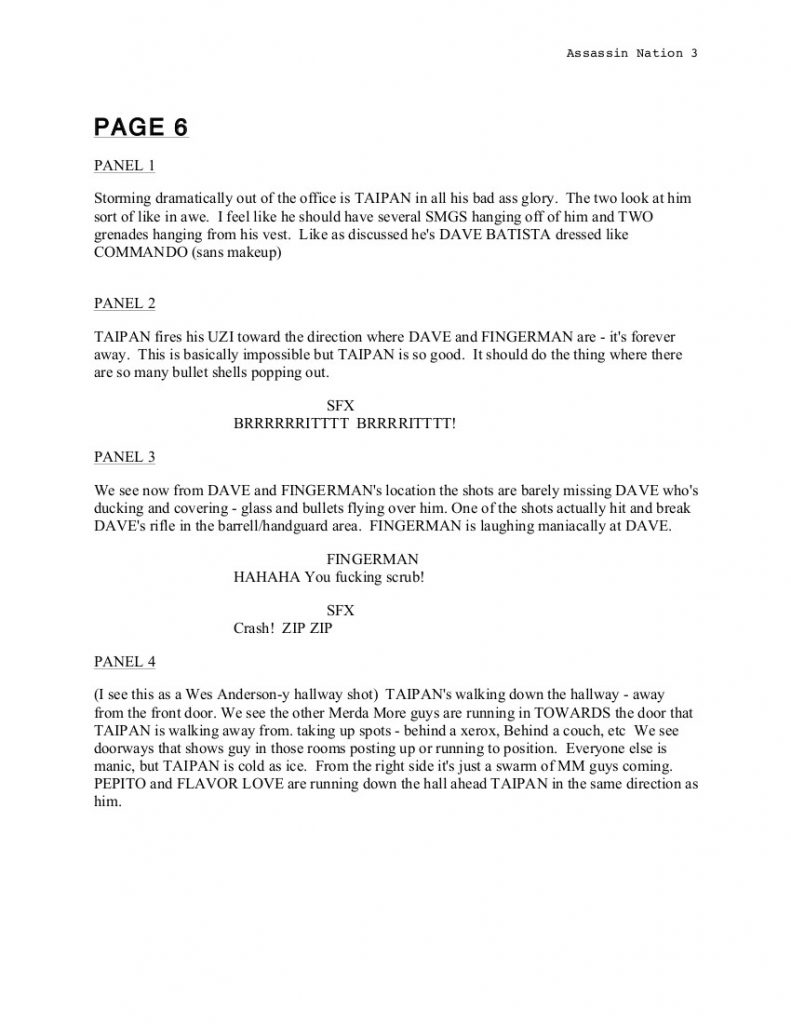
The script from Assassin Nation #3, Page 6 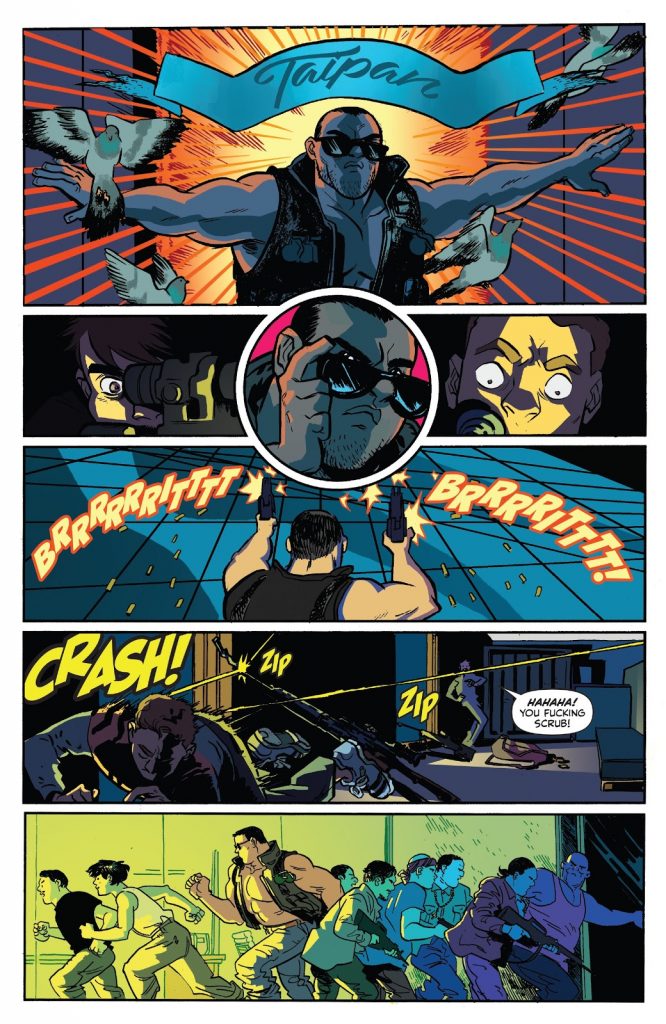
Page 6 of Assassin Nation #3
Let’s talk about Taipan. He arrives in an extremely action movie-y sort of way, with birds entering alongside of him as if he’s a character in a John Woo movie. Except they’re pigeons instead of doves, which is a nice twist. How important is it for you to work nods to the history of action movies into the story, and perhaps more importantly, to change them just a little different?
KS: So, Taipan’s intro was 100% Erica Henderson. I wrote “he dramatically busts through the doors”, Erica said we need a banner and the birds. I mean, I’m in love with it. I’ve written a ton of action movie style books, KILL THEM ALL is literally a Woo influenced book and I didn’t get any birds in there. Finally dramatic birds in one of my books! But yeah, that is all Erica. She’s incredible.
I wanted to ask about the action sequence in this issue, because it’s a whole lot of the issue. You and Erica are obviously simpatico as collaborators, but still, you probably have a specific vision as to how this could play out. How tightly do you script a sequence like this out? Is it pretty focused on what you think you should happen, or do you mostly layout the broad strokes and Erica just figures it out on the page?
KS: I script them completely out. I think action scenes, like comedy, require a certain amount of pacing and I think that they should tell a story also. That’s the wrestling fan in me – a fight should, often, be more than just a fight. It should say something more about those involved or advance the story in some way so what happens in them is important.
Two variants to that last question: how differently would you write that scene for yourself, and how differently do you think you’d have to write that for an artist you don’t know as well?
KS: It’d be the same, either way.
BUT, I do have to say it’d be different if it wasn’t Erica – and that goes all the way through this book. I will always give myself more work, more stuff to cram on a page. In issue #1 of Rock Candy Mountain I had a very specific action scene and had very few pages to do it and I have something like a 16 panel page. I wouldn’t ask most anyone to do that. In Rick and Morty, I try to NEVER go over 6 panels in a page. In a lot of the early Mars Attacks issues I knew Chris Schweizer had other projects and I tried to keep it the same.
Erica and I had a discussion at one point about how nonsense like that is sort of what made a Kyle Starks Book a Kyle Starks Book and I definitely ask more of her than I would of someone other than myself but only because it was established that she Gets It and wants to make something special together. That type of willingness and understanding from a co-creator I don’t even have words for. Erica is amazing and great and I can’t say enough to really elucidate all of that. All that being said I don’t think I have too many HIGH panel count pages in this book. I hope? Sorry, Erica?
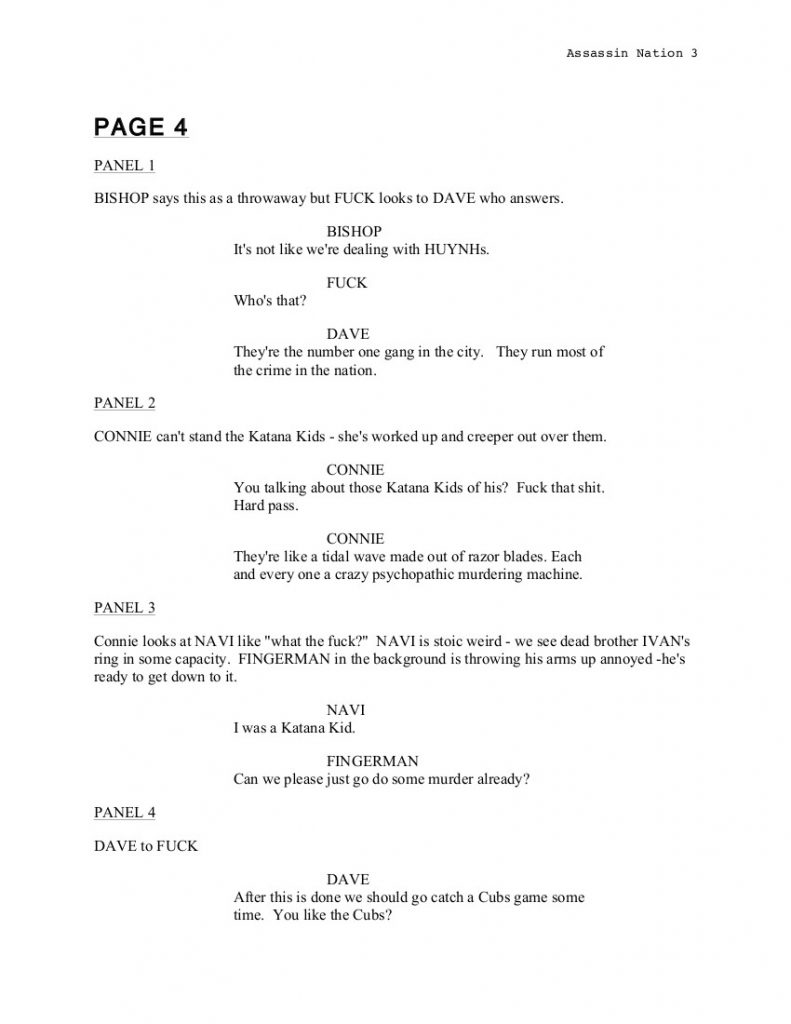
The script from Assassin Nation #3, Page 4 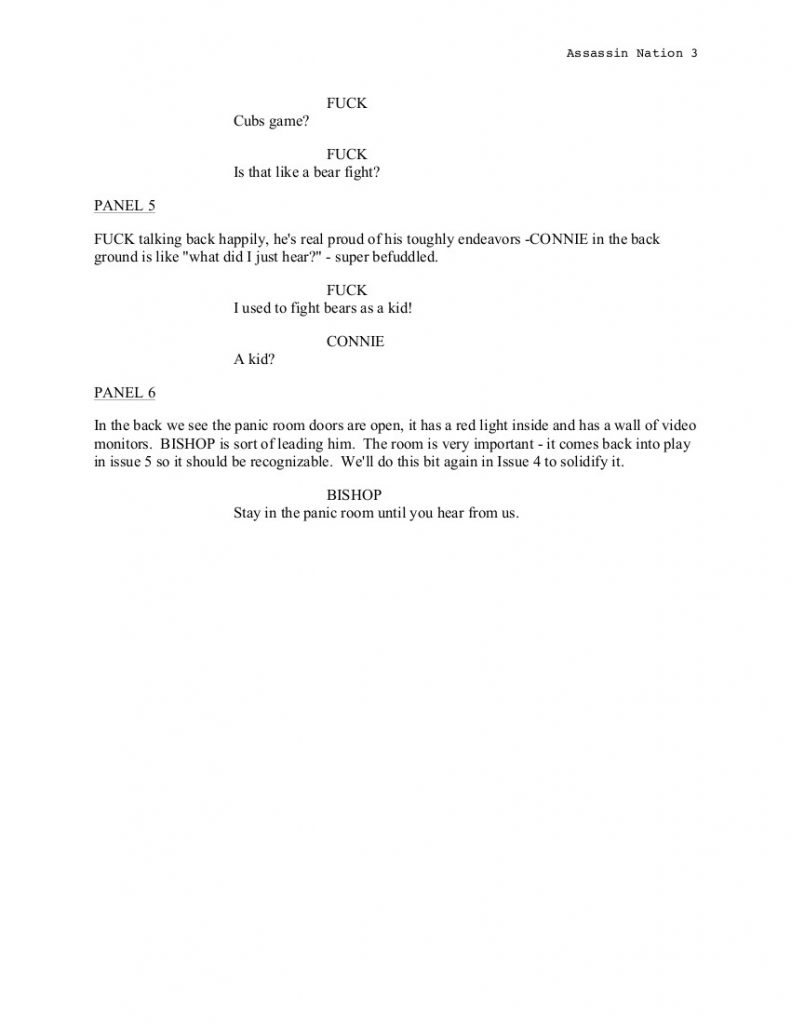
The script from Assassin Nation #3, Page 4 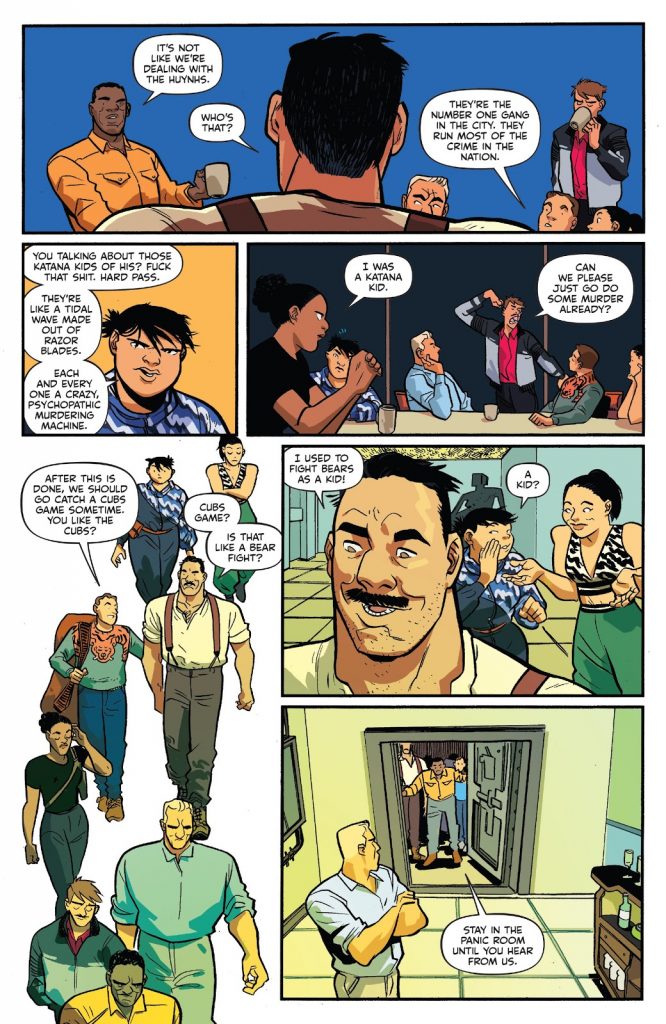
Page 4 of Assassin Nation #3
Obviously you have a crack team with Erica, Deron and Jon and the rest of Skybound involved. But I’m curious where you enter back in during the process? What other steps do you as the writer get involved with on Assassin Nation, and what exactly does that entail?
KS: Generally after the script gets turned in and any agreed upon changes are made from notes, my next step is approving the art – sort of unofficially? Erica always shows me her pages as she finishes the pencils stage so it’s basically only to make sure that I didn’t fail to properly describe or address something in script that caused her to misrepresent something. This pretty much never happens.Mostly at this stage is me making a lot of dramatic fan noises as she shows me pages and waving my arms and screaming in joy a lot. Sometimes she asks me for SFX I left out.
That, I think, says a lot about how professional and excellent Erica is and also how much she likes the script and it’s the product we both want to make.
THEN, I don’t do anything until the letterer does their thing. I don’t do a lettering pass but I might tweak that first round of letters but it’s always basically nothing. Very minor stuff.
For an issue like #3, how much do you change up the script at all when you’re going through the lettering proof? And if you do, what are you looking for in particular?
KS: I don’t really do lettering proofs. As long as the artist doesn’t stray from what I’ve written – and Erica most certainly doesn’t in regards to the heart of the panel and the general action – then my dialogue from my script is still exactly what that panel calls for. The only thing that I look to do in a lettering pass is see if what I wrote still reads well when I see it in a bubble. Sometimes I change a couple of words, sometimes I might break a bubble into two bubbles.
I feel like my dialogue is, in a lot of ways, my bread and butter and I’m writing for that dialogue along with story beats so I’m not likely to make a major alteration unless the art drastically reads different. As long as you’re working with a pro that’s not going to happen without some heads up reason why – especially in an action/comedy book. The pacing is important so the panels are important and thus the dialogue is important.
Thanks for reading the first interview from Assassin Nation Week. Come back tomorrow for an art feature interview with artist Erica Henderson. Also, if you’re enjoying this content, consider subscribing to SKTCHD to get content like this on the regular!
